Northwest Region (Cameroon)
The Northwest Region, or North-West Region (French: Région du Nord-Ouest) of Cameroon is part of the territory of the Southern Cameroons, found in the western highlands of Cameroon. It is bordered to the southwest by the Southwest Region, to the south by the West Region, to the east by the Adamawa Region, and to the north by the Federal Republic of Nigeria. Bamenda is the capital of the region. Various Ambazonian nationalist and separatist factions regard the Nord-Ouest region as being distinct as a polity from Cameroon.[2]
Northwest Region | |
|---|---|
 Location of the Northwest Region within Cameroon | |
| Coordinates: 6°20′N 10°30′E | |
| Country | Cameroon |
| Capital | Bamenda |
| Departments | Boyo, Bui, Donga-Mantung, Menchum, Mezam, Momo, Ngo-Ketunjia (Ngoketunjia) |
| Government | |
| • Governor | Adolphe Lele Lafrique (2012–) |
| Area | |
| • Total | 17,300 km2 (6,700 sq mi) |
| Population (2015) | |
| • Total | 1,968,578 |
| • Density | 110/km2 (290/sq mi) |
| HDI (2017) | 0.602[1] medium · 5th of 10 |
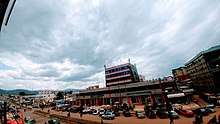
Identity Politics in Colonial Africa: Fulani Migrations and Land Conflict, Taylor & Francis, UK, 2016, p. 20</ref> In 1919, the administration of Northwest Region became only British. In 1961, the region joined the Cameroon.[3] Separatists from the Ambazonia administration regard the both the Nord-Ouest (Northwest) and Sud-Ouest (Southwest) regions as being constituent components of their envisaged breakaway state.[4]
Administration
The Northwest Region (known before 2008 as the Northwest Province) is the third most populated province in Cameroon. It has one major metropolitan city, Bamenda, with several other smaller towns such as Wum, Kumbo, Mbengwi, Ndop, Nkambé, Batibo, Bambui and Oshie. The province saw an increase in its population from approximately 1.2 million in 1987 to an estimated 1.8 million in 2010.[5] The population density of 99.12 people per square kilometer is higher than the national average of 22.6. The provincial urban growth rate is 7.95%, higher than the national average of 5.6%, while the rural growth rate, at 1.16%, is equal to the national rate. In 2001, according to the Statistical Provincial Services of the North-West Province, the population of the province is young, with over 62% of its residents being less than 20 years old. Therefore, the dependency rate in the province is high, particularly in the rural areas.
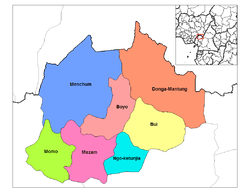
Like other regions in Cameroon, the Northwest Region is made up of administrative divisions. The province was created in 1972 with five divisions or departments: Bui, Donga-Mantung, Menchum, Mezam, and Momo. Today, it has seven divisions, the additions being Boyo, which was carved out of the Menchum division, and Ngo-Ketunjia or Ngoketunjia, split off from the Mezam division. Each division is further subdivided, with thirty-one total subdivisions in the Northwest Province. The basic unit of local government is the council, and there are thirty-two councils in the region.
Population
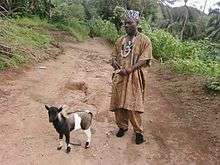

| Year | Pop. | ±% p.a. |
|---|---|---|
| 1976 | 980,531 | — |
| 1987 | 1,237,348 | +2.14% |
| 2005 | 1,728,953 | +1.88% |
| 2015 | 1,968,578 | +1.31% |
| source:[6] | ||
The Northwest Region has many ethnic groups, including immigrants from other regions and countries. Nigeria is well represented, as it borders the region to both the north and the northwest. The native population comprises a variety of ethnic and linguistic groups. The main ethnic groups are of Tikar origin: Tikari, Widikum, Fulani, and Moghamo. The most widely spoken languages in the province include Mungaka, Limbum spoken by the Wimbum people of Donga Mantung Division; Yamba, spoken by the Yamba people also of the Donga Mantung Division; Bafmen, Oku, Lamnso, Ngemba, Pidgin English, Balikumbat, Papiakum, Moghamo, and Nkom. During the colonial period, administrative boundaries were created which cut across ethnic groups and cultures. As a result, parts of some ethnic groups now lie in different divisions and provinces, which is believed to have led to several land conflicts.
In the provinces, the social organization recognizes a chief as its head, also called the Fon. The Fons, who in their tribal area may be more influential than the official administrative authorities, are considered the living representative of the tribal ancestors.
Politics
The Northwest is a stronghold of the Social Democratic Front (SDF) which is one of the main opposition parties of Cameroon. Some Northwesterners feel completely marginalized by the government. There is also a secessionist movement, the SCNC (Southern Cameroon's National Council) whose goal is to secede from Cameroon and form a republic consisting of the English-speaking regions. Much of the SCNC's influence exists in the Northwest. In 2008, the President of the Republic of Cameroon, Paul Biya, signed decrees abolishing "Provinces" and replacing them with "Regions". The Northwest Province subsequently became the Northwest Region.
Natural attractions
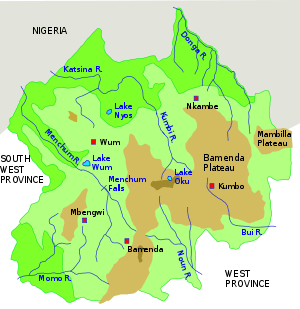
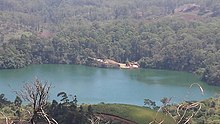

The Northwest region has unique attractions, including the second highest mountain in West Africa. It is home to many rare birds such as the distinctive red crested Bannerman's turaco, which is unique to this region. There are also many crater lakes such as Lake Oku, Lake Awing, and Lake Nyos. The largest remaining mountain forest in the Northwest Region is the Kilum-Ijim Forest. Menchum Falls, and Abbi Falls in the Mbengwi Division, are also located here.
Gallery
- Culture
 Music instrument
Music instrument







 North West Woman Traditional dress
North West Woman Traditional dress
Traditional Musical Instruments

 Pointed head Sanza
Pointed head Sanza Sanza
Sanza Single rattle shaker and double round double shaker
Single rattle shaker and double round double shaker Traditional Xylophone and drum
Traditional Xylophone and drum Nkeng (Double Gong)
Nkeng (Double Gong) Calabash
Calabash
 Cabaca
Cabaca
 One sided long drum
One sided long drum




 Flute
Flute Guitar
Guitar
References
- "Sub-national HDI - Area Database - Global Data Lab". hdi.globaldatalab.org. Retrieved 13 September 2018.
- Tatah-Mentan, I., and F. Achankeng. "Stopping war before it starts: testing preventive diplomacy in the selfdetermination case of British Southern Cameroons (aka Ambazonia)." British Southern Cameroons: Nationalism & Conflict in Postcolonial Africa (2014): 127-170.
- Emmanuel Mbah, Environment and Identity Politics in Colonial Africa: Fulani Migrations and Land Conflict, Taylor & Francis, UK, 2016, p. 21
- Adepoju, Paul. "World Report Hospital attack in anglophone Cameroon kills four patients." (2019).
- Government of Cameroon. "La Population du Cameroun 2010" (PDF) (in French). Archived from the original (pdf) on 28 May 2015. Retrieved 17 March 2013.
- Cameroon: Administrative Division population statistics
| Wikimedia Commons has media related to Northwest Region. |
- "Background Note: Cameroon". 2010. Government of Cameroon. Accessed 11 March 2013.